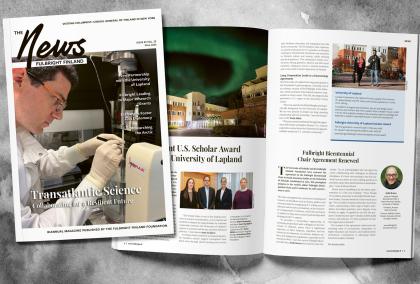Do I need to open a bank account in Finland?
The grantee can decide whether to open a bank account in Finland or not. The Foundation can pay the grant to a Finnish, U.S., or any other account that doesn’t cause extra expenses for the Foundation to make a payment. Paying the grant to a Finnish or U.S. bank account doesn’t cause extra expenses for the Foundation. However, the grantee may need to pay international transaction fees from the grant payment if they choose to use their U.S. bank. It is always the grantee’s responsibility to pay any extra costs (e.g. international transfer fees) if those are incurred from receiving the grant payment.
Please note that, especially for those staying in Finland for a longer period, alumni have found that living without a Finnish bank account can be inconvenient and limiting. While it is possible to manage without one, having a local bank account makes daily life significantly easier, as many aspects of Finnish society are tied to bank-based identity verification. For more details, please refer to the section below titled "Benefits of opening a bank account in Finland'."
The grantee is responsible for opening the bank account on their own. The Fulbright Finland Foundation does NOT open bank accounts for the grantees.
If you are a short-term grantee, please note that according to the information that the Foundation has received from Nordea Bank, international guests staying in Finland for less than 90 days and who thus do not have a Finnish residence permit card are not able to open a bank account in Finland. If your grant period is 90 days or less and you do not have a residence permit, please contact your program coordinator at the Foundation to discuss the options.
To avoid potential issues with your U.S. bank account (deactivation, locking etc.) while in Finland, consider adding an authorized signer before departure. Both you and the person must visit the bank together to complete the paperwork and show valid ID.
Benefits of opening a bank account in Finland
- If you open a bank account in Finland and acquire a Finnish ID card or an identity verification certificate i.e. todistus ensitunnistuksesta from the Police, you are able to receive online banking codes with a strong electronic identification function. You can use these codes to prove your identity safely in various electronic services, which are extremely common in Finland. For example, booking appointments with private and governmental agencies and companies, making purchases online, or signing up a child for daycare often require these codes.
- You receive your grant faster as the Foundation pays your grant from its Finnish bank account. It can take approximately five business days to receive the grant from Finland to a U.S. bank account, whereas inside Finland, the transfer usually takes place on the same day or the next.
- You receive the exact grant amount awarded to you if it was announced to you in euros. If you use your U.S. account, the EUR-USD currency rate fluctuations impact the actual grant amount you receive, and extra fees are deducted from the grant payment due to the international bank transfer.
- You can pay bills faster and cheaper in Finland. Using a U.S. bank account for the payment of bills in Finland may cost extra, and the transaction may take a longer time.
- If you wish to use cash in Finland, it may be cheaper to draw money from a Finnish bank account than to draw money from a U.S. bank account or a U.S. credit card (that may have additional international transaction fees).
- If you work in Finland, for example, and have a summer job, your employer may require you to have a Finnish bank account for salary payment purposes.
Disadvantages of opening a bank account in Finland
The process takes time. Depending on the Finnish bank you choose and the location of the bank, the time it takes to open a bank account varies. Previous grantees have reported that the opening process can take up to a few weeks to three months. Thus, we recommend that you speed up the process by making sure you have all the required documents with you when visiting the bank (please see the list below). Nowadays, banks are required to be well aware of the source of the customer’s money transferred/deposited into the bank’s account, which is also a factor that has lengthened the bank account opening process in recent years.
If you wish to receive your grant to a Finnish bank account, please note that opening an account in Finland can take up to a few weeks to three months. You will be dependent on your own finances during this time.
When would you manage without a Finnish bank account?
If your stay in Finland is short, for example, 3 months, and you don’t need to pay bills in Finland, you can often manage without opening a bank account in Finland. In this case, it doesn’t necessarily make sense to open an account in Finland since opening a bank account can take weeks or months.
Which Bank To Use?
If you open an account in Finland, you are free to select which bank you wish to use. Ask your Finnish host university's International Office which local bank they recommend for international visitors. Usually, the International Office staff and the international student tutors have experience regarding which bank in your host town is most familiar with handling international customers’ banking matters.
U.S. Fulbright grantees in the past have used several Finnish banks, for example:
Some grantees have also used their U.S. account for grant payment purposes and have not opened an account in Finland. A few grantees have also used the following service instead of a regular Finnish or U.S. bank:
- Wise
‘’ I have been very satisfied with my experience with Wise. Opening an account was quite easy. If I recall I only needed to take a picture in the mirror holding my passport for identity verification. I was also able to order a debit card and complete the whole process from the U.S. before I left. That was very helpful because the housing company in Finland wanted payment for the first month to their IBAN number before arrival. You can receive free account information in a variety of currencies. In my case, I only have EU and U.S. details.”
Book an appointment for opening an account
If you wish to open an account in Finland, you need to make an appointment with them by calling their customer service. Banks can have a separate phone number for services in English. When you book an appointment with the bank, will be given the address of the local bank where you need to go for the appointment.
When calling the bank to book an account opening appointment, remember to ask what documents you are required to bring along for the visit.
Arrive prepared for bank account opening
The procedures for opening an account may vary between banks and even between different branches of the same bank. Every individual situation can also be a little different with each grantee, which is why it is difficult to give fail-safe banking instructions that would apply in all cases.
The best approach is
- to be prepared with all of the paperwork. Make sure to take to the appointment all those documents advised to you when making the appointment, as well as the ones listed on this page.
- to visit the bank together with a Finnish-speaking person, for example, with your Fulbright Buddy or university tutor. If you go alone, ask the teller to write down in Finnish and English what is still missing or what the problem is so that we can help you, if needed, to complete the process.
Usually, the following documents are needed at the first banking appointment:
- Form from the Digital and Population Data Services Agency DVV stating your Finnish ID number and that you are officially registered to live in Finland
- Passport
- Residence permit card
- Study certificate/invitation letter from the Finnish host institution
- Fulbright documents
- A recommendation letter from your current bank (“customer in good standing”) - this document might sometimes be asked for
If you already have a Finnish ID card, do also take that with you to the bank in order to receive banking codes applicable for strong identification.
If you are not eligible for a Finnish ID card (in Finland for less than a year), you can receive the strong identification codes from the bank by first filling in an application for so-called todistus ensitunnistuksesta (an identity verification certificate) with the bank clerk and then submitting the form to the Police. Remember to ask for the form at the bank during your appointment.
Please find further information on strong identification as well as instructions on applying for the Finnish ID card and todistus ensitunnistuksesta (an identity verification certificate) here.
Banking Services
After opening a bank account in Finland, the customer is usually offered a Visa Electron debit card. Online banking services are usually offered for clients staying in Finland for a longer period of time, for example, a minimum of 6 months.
You will not need a Finnish credit card. Visa Electron is sufficient for most purposes.
Paying Bills
Ask someone to run through how to make online payments with your account. This is the way business is done in Finland, other than store purchases. If you have not received online banking codes, you can use your Visa Electron debit card to pay bills by using the banking machines (ATMs). Bank agents can provide guidance on this.
NOTE: Checks are not used in Finland.
Grant Payments
Grant can’t be paid without submitting first all the required documents/info. The grant payments made by the Fulbright Finland Foundation are made on the first day of each month.
All grantees must bring enough funds to cover room and board for at least the first 4 weeks in Finland. It is also wise to be prepared for other settling-in costs, such as bus passes, mobile phone deposit, and student housing deposits. Many of these expenses may have to be dealt with before your first grant payment and can easily add up to USD 2 000 or more.
The grant allowance is intended to assist with living costs in Finland. It bears no relation to the grantee’s salary in the United States nor is it meant to pay for the travel expenses or tuition of dependents. It is not intended to cover extraordinary project costs, such as film, art materials, extensive photocopying, and so on.
Grantees should be prepared to make some adjustments if need be. For example, apartments are usually smaller than those in the United States. The prices of most things do not vary remarkably from their counterparts in the United States, but some items can be much more expensive. The maintenance allowance will not suffice to cover major purchases of winter wear or sports equipment. Furthermore, the allowance has not been designed to cover travel in Europe during or after the grant period.
It is important to note that internationally the funding for Fulbright grants comes from a number of sources and it very much depends on the country as well as the particular grant program. In approximately 50 countries around the world, there is a bi-national commission that administers the Fulbright program and each of the commissions is unique (and different from each other) in many ways. The Fulbright Finland Foundation is an independent binational commission. Approximately 80% of the funding of the Finnish Commission comes from Finland.
The maintenance allowances in the majority of grant categories are paid by the Fulbright Finland Foundation from a Finnish account. Please note, there are three exceptions: the Specialist program, the Fulbright Distinguished Awards in Teaching Research Program, and the Fulbright-EDUFI Fellowships program.
- IIE is responsible for the grantee's monthly allowance (honorarium) and travel grant for the participants of the Specialist Program,
- IREX handles the payment of the Fulbright Distinguished Awards in Teaching Research Program grantees, and
- the grantee's host institution pays the grants for the Fulbright-EDUFI Fellowships program grantees.
The maintenance allowance paid by the Foundation is normally for 9 months (one academic year) or 4-6 months (one semester). Grantees will receive their allowances from the Foundation in equal monthly installments, paid directly into their bank accounts on the first day of the month. The first monthly payment will be made during the first week of September/January if the grantee has delivered their bank details to the Foundation by that time.
The Foundation will deposit the travel and residence permit allowance to each grantee after the grantee has completed all the required pre-departure paperwork.
To start grant payments, please complete the Contact and Bank Information Form and send it to your program coordinator.
Additional Income during the Fulbright Grant Period
The grantee is required to notify the Foundation if they are offered an honorarium, lecture fee, or other salaries during the grant period. Student grantees may not undertake remunerative employment during the grant period without prior written approval by the Commission. Grantees are reminded that Finnish legislation on taxes and work permits regulates accepting payments while in Finland.
Residency Restrictions
The grantee will not be entitled to any maintenance allowance until they take up the assignment in Finland. The initial maintenance payment will be made shortly after the grantee’s arrival in Finland to take up the project.
If for any reason the grantee, during the term of this grant, ceases to carry out their project or activity, the maintenance allowance and other grant benefits may be suspended until the grantee resumes their project or activity.


